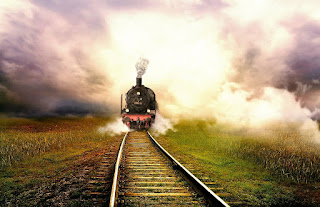17 Relativistic train paradox
Hello
Today, I would like to take a look at the questions posted at https://physics.stackexchange.com/. The contents are as follows. There is an iron bridge. This bridge cannot withstand the weight of the entire train, but if it only has to support part of the train as shown in Figure 1 below, it can do it.
 |
| Figure 1. Non-relativistic consideration, if only a part of the train is on the iron bridge, the iron bridge will not collapse |
Therefore, when the train runs slowly, it is placed only on a part of the bridge, so the bridge does not collapse. (Click below to see the original.)
However, if the length contraction is correct, it will be as shown in Figure 2 below. The train is contracted, the entire train is placed on the bridge, and the bridge must collapse.
 |
| Figure 2. When the observer on the ground sees it, the entire train has come up and the iron bridge must collapse (Length contraction) |
However, from the standpoint of the person on the train, the story is quite different. Inside the train, the length of the bridge is reduced, as shown in Figure 3, so that only part of the train is on the bridge. Then the iron bridge does not collapse.
 |
| Figure 3. When a person in a train observes, only a part of the train is raised and does not collapse (Length contraction) |
For a person on the ground, the iron bridge must collapse, and the person in the train should not break the iron bridge. If so, does this bridge collapse? Will not it collapse? If both sides are right, this is a paradox. I think it would be called "train paradox." Do you have a solution to this problem?
.
.
.
.
.
.
.
If you think of this problem as a length expansion, the problem is solved easily. First of all, if a length expansion occurs from an observer on the ground, only a part of the train will be placed, and the bridge will not collapse.
 |
| Figure 4. When the observer on the ground sees it, only a part of the train is raised and does not collapse (Length expansion) |
Now, let's look at it from the perspective of the observer in the train. The weight of the train did not change. However, the length of the orbitals of the atoms that make-up the iron bridge and the iron bridge increases. Therefore, the overlap of the orbitals of atoms constituting the iron bridge increases with the ratio of γ. Therefore, the strength of the bridge becomes stronger and the bridge does not collapse accordingly. Therefore, there is no paradox.
 |
Figure 5. When a person in a train observes, the entire train is on an iron bridge, but the overlap of the orbitals of the iron atoms increases so that the bridge does not collapse |






Comments
Post a Comment